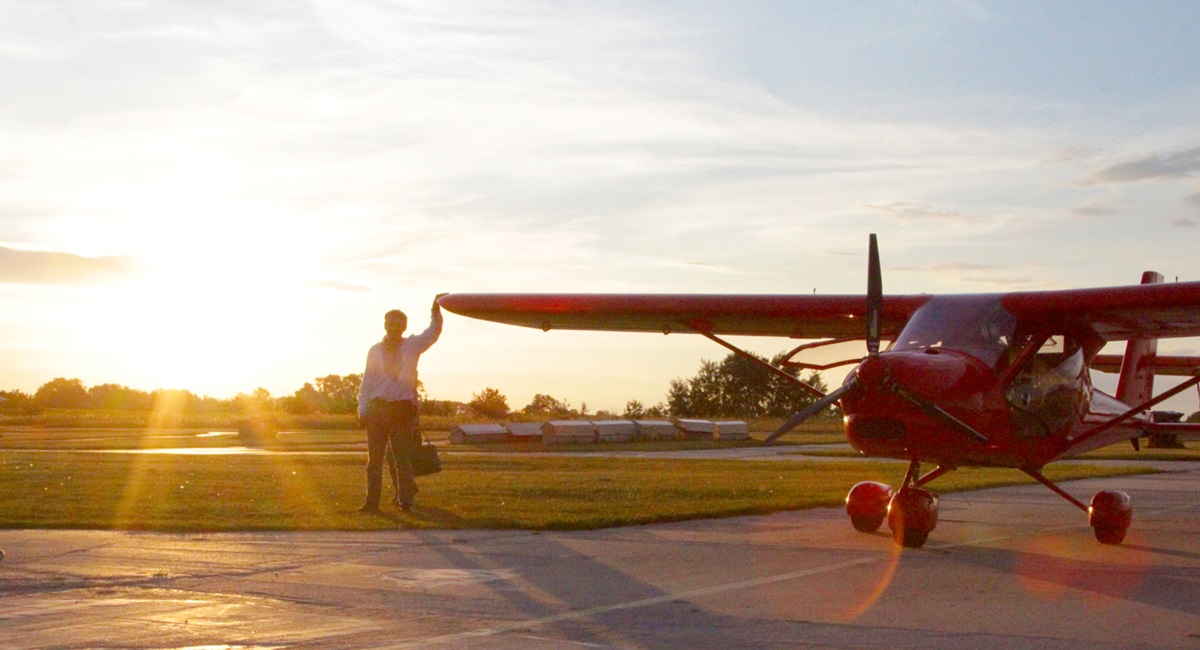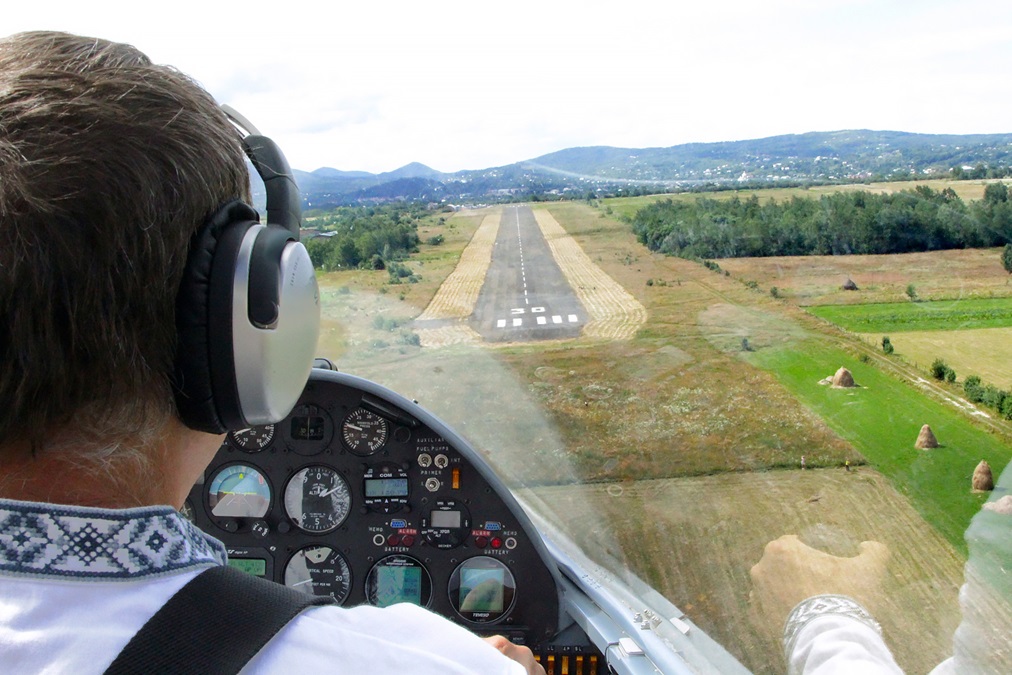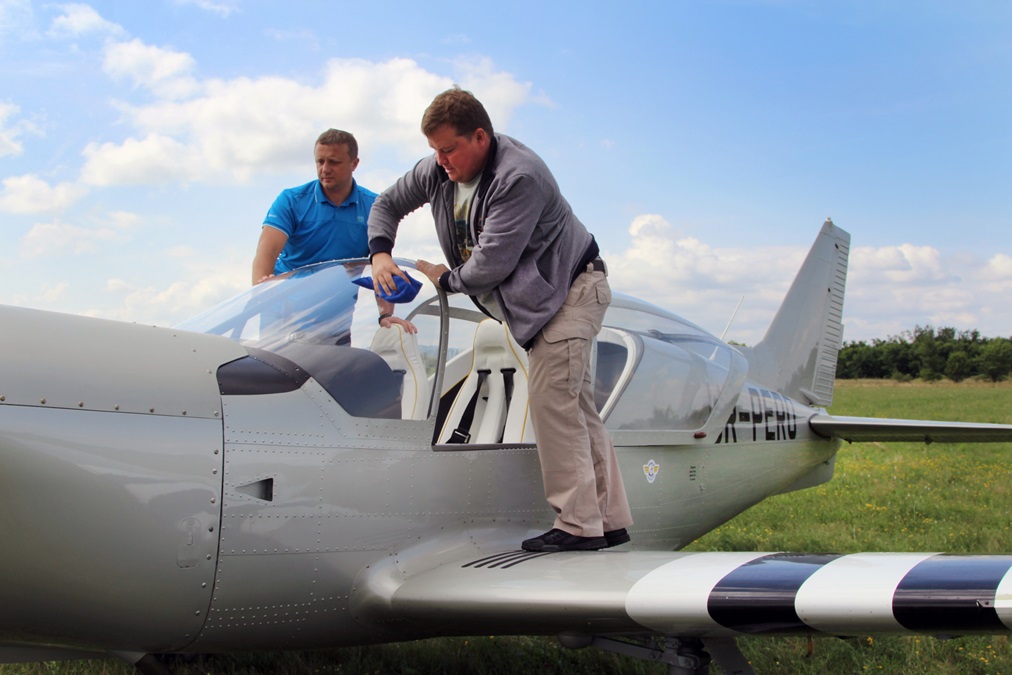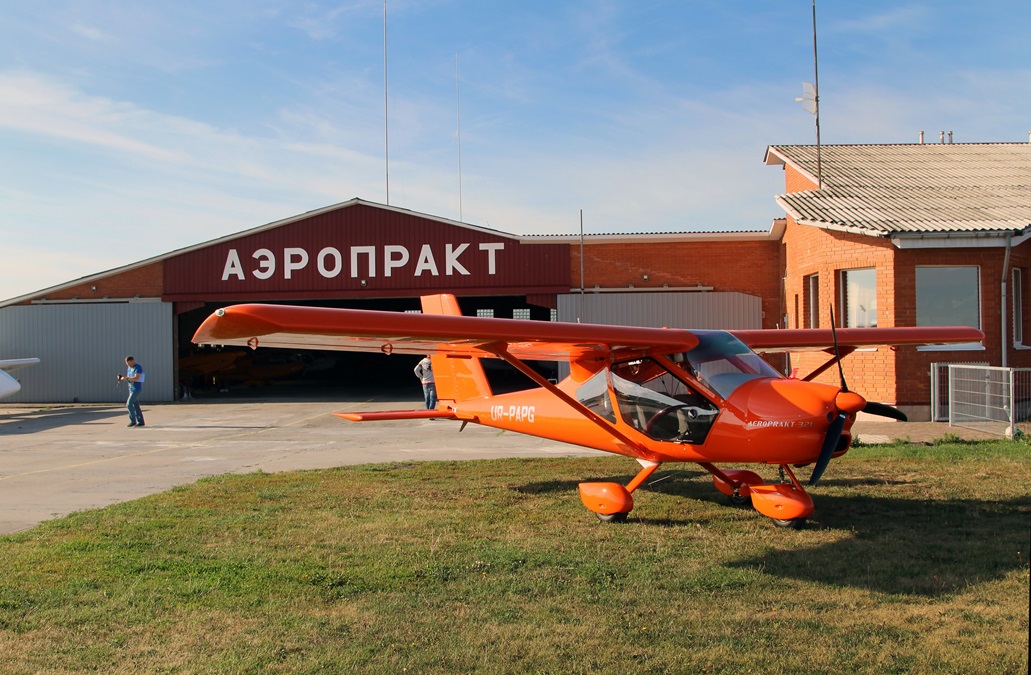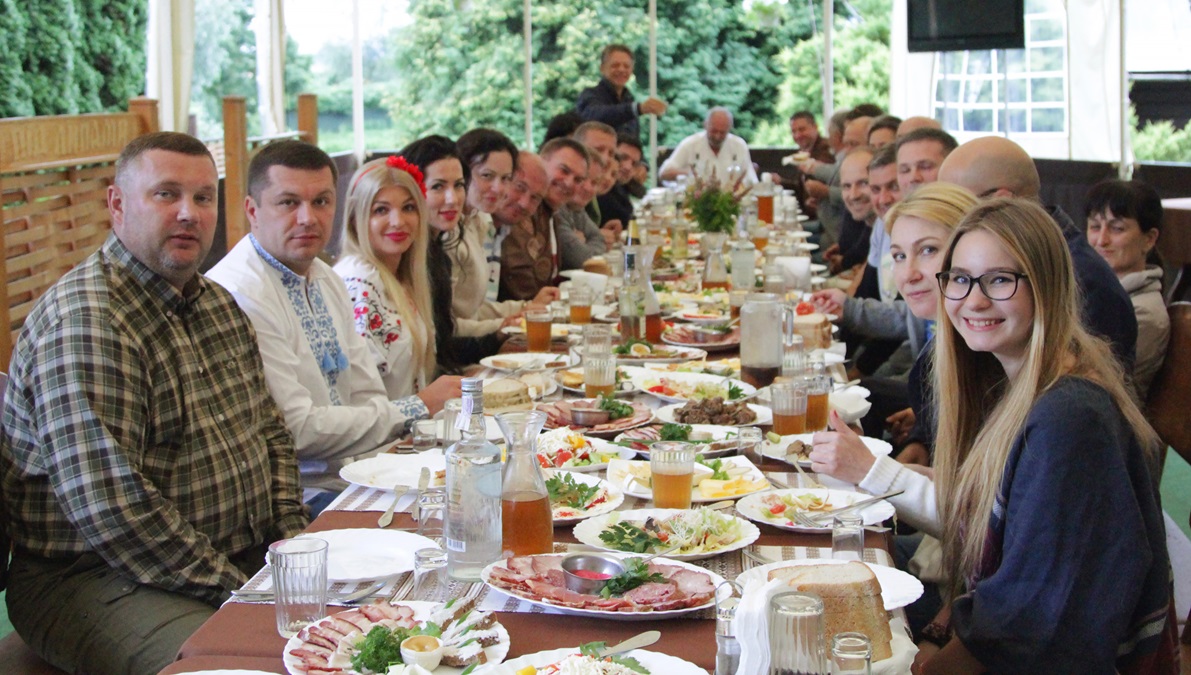Flying in Ukraine
An American pilot learns to fly low, slow, and tranquil
By Ben Moses
Sometimes life seems to be one long series of chance encounters, spinning you off in a direction you may have only imagined the day before.

I was connecting in Paris on a trip to Ukraine to work on a documentary film about the country’s recent revolution. At the Air France departure gate I sat down next to a man in his fifties wearing a T-shirt with the image of a single-engine airplane printed on the front. “Are you a pilot?” I asked hopefully.
“Yes,” he answered. On our flight to Kyiv (Kiev), Ukraine, I learned that Yuriy Yakovlyev had designed and built his first small airplane at the age of 21. It caught the attention of executives at the old Antonov Aeronautical Scientific-Technical Complex of the USSR, who subsequently hired him. After the collapse of the Soviet Union in 1991, Yakovlyev and a couple of friends started building their own airplanes, a project that evolved to become the Aeroprakt Aircraft Company, a manufacturer of Light Sport aircraft sold all over the world.
“We’re having a fly-in in Kosiv in July,” Yakovlyev told me. “You’ll have to come!” Whatever or wherever Kosiv was, I was in.
But isn’t there a war in Ukraine? The country is the size of France and, yes, 7 percent or so of it is a stalemated war zone—in the eastern part, next to Russia. It’s an area known as Donbas, which encompasses the mining and industrial cities of Donetsk and Luhansk. Outside that area, it is peaceful and safe.
Kosiv is a charming village in the Carpathian Mountains and a favorite weekend destination. Yakovlyev says there are close to 2,000 private pilots in Ukraine—up from zero in the Soviet days, when private aviation was forbidden. Even so, clever aviation enthusiasts such as Yakovlyev created “flying clubs in assistance of the Red Army.”
Yakovlyev recommends downloading AirNavPro for my iPad, and I spend Friday evening plotting the route. It will take us on a general southwest course, by the city of Zhytomyr, over the ancient city of Khmelnytskyi, then on to Chernivtsi, where we’ll spend the first night not far from the Romanian border.
At 6 a.m. on this pretty Saturday morning, Yakovlyev picks me up and we drive to his company field 20 miles west of Kyiv. We’ve got a high, thin overcast and 21 degrees Celsius across the route, perfect for smooth flying at about 2,300 feet agl. By 7 a.m. a dozen or so pilots and friends are gathered in the Aeroprakt operations building to discuss route and weather, and file online flight plans—mandatory only because we’re flying to a towered field.
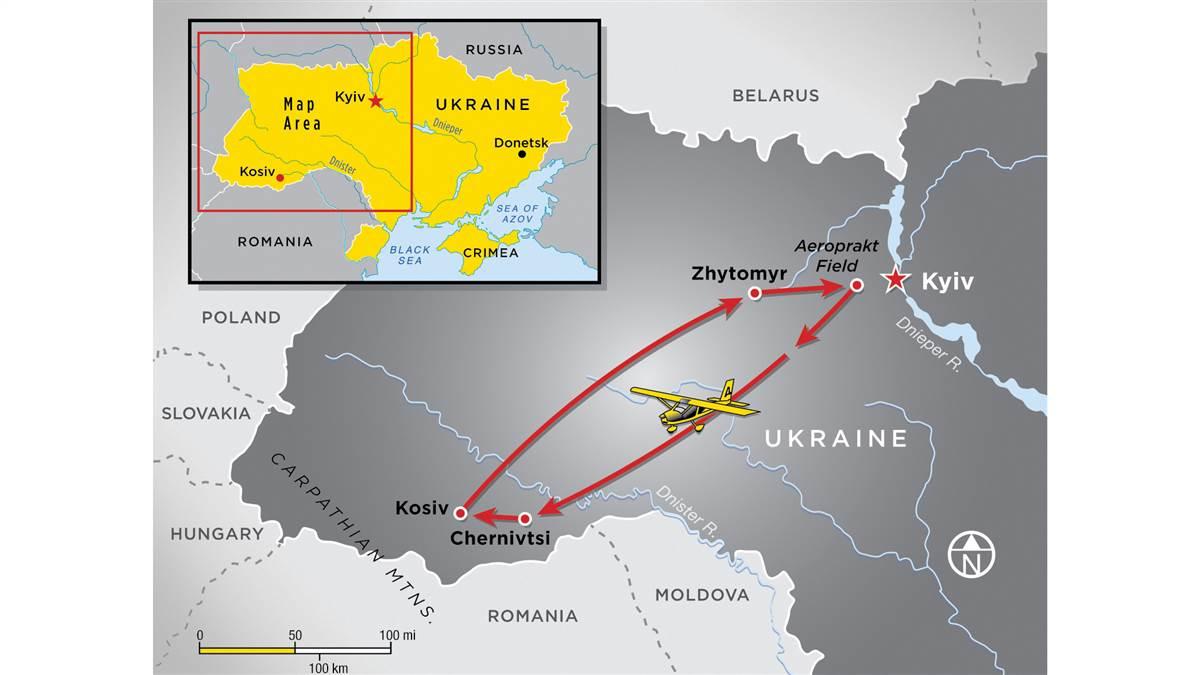 I’m assigned to UR-PAPK, a little red Aeroprakt A32 with a Rotax engine. We’ll cruise casually at 180 kilometers per hour (97 knots), burning 17 liters (4.5 gallons) of mogas per hour. We’ve got a 10-knot headwind, so our time en route will be 2.5 hours. I’m flying left seat, but not PIC. My right-seat guide is Vitaly, a seasoned pilot who spent three years flying tourists around Nepal.
I’m assigned to UR-PAPK, a little red Aeroprakt A32 with a Rotax engine. We’ll cruise casually at 180 kilometers per hour (97 knots), burning 17 liters (4.5 gallons) of mogas per hour. We’ve got a 10-knot headwind, so our time en route will be 2.5 hours. I’m flying left seat, but not PIC. My right-seat guide is Vitaly, a seasoned pilot who spent three years flying tourists around Nepal.
We preflight with the others: four more single-engine models and Yakovlyev and his wife, Alia, in their A36, a twin-engine, tandem-seat ship that’s Yakovlyev’s pride and joy. He designed it—as he did all of these aircraft.
The little bird I’m in is comfortable enough for two adults and bags. It has huge windows all around, the sides reaching to below the level of my seat, making it feel more like a helicopter than any airplane I’ve flown. It even includes an emergency airframe parachute.
The design and machining of the aircraft are done in Ukraine, with a completion facility in Poland. They’re turning out 70 aircraft a year, and when I ask Yakovlyev why they don’t promote them more in the United States he says, “We’re already selling every one we can build.” (See “Ukraine’s War Not a Hindrance,” page 73.)
Our airplanes are flying a few miles apart, Yakovlyev leading in his faster A36, UR-PAPE. Except for the English standard phonetics for our call signs, Yakovlyev talks to controllers in Russian, so occasionally I key the radio and ask for a report to be repeated in English. I’m relieved to find that each time the controllers are easily understandable. My Russian and Ukrainian vocabularies consist mainly of how to ask for coffee, the bathroom, and a room for the night.
The en route system doesn’t have controllers, per se. It’s an optional advisory service more like Flight Watch. Here they’re called Informatsi (“information”) and with very few radar centers in Ukraine, offer weather advisories and a semblance of flight following. Frequencies and areas of coverage are on the charts.
Cross-country VFR in Ukraine below 5,000 feet msl is simple; above that, you’re in controlled airspace and must communicate more. Below 5,000 feet if you’re flying between nontowered airfields—and there are plenty—you don’t have to talk to anyone. Be sure to dodge the restricted, prohibited, and military areas.
Cruising slowly, we pass half a mile over ancient city-forts surrounded by formidable rivers, and across hundreds of square miles of summer wheat, corn, and sunflowers, among other crops. Ukraine is known as the breadbasket of Europe, which is why it’s been fought over for so many centuries. Much of it looks like Kansas and Nebraska.
We fly over vast, dense hardwood forests, often strangely hollowed out in the middle by clear-cutting. I ask Vitaly why, and he says it’s done by unscrupulous loggers ignoring cutting restrictions and making a hefty living in cash transactions—nothing an inspector can perceive from the ground.
Vitaly lets me make the approach into Chernivtsi International Airport, but he’s not an instructor, and my off-centerline wanderings on short final make him nervous. Twenty feet above the runway, 15 knots above stall speed, and still not in full control I feel his hand grab mine on the throttle and control of the yoke is wrenched away. I had it! I want to say, but I didn’t have it. How the heck can you fly an airplane so slowly?
Taxiing in, we’re greeted by Chernivtsi’s mayor and a dozen or so cameras and microphones. Yakovlyev and Vladimir Zakarchuk, the Chernivtsi flying club president, are celebrities in the aviation community, and spend at least 45 minutes promoting private aviation to attentive media. By the time everyone arrives, including several helicopters, there are about 15 aircraft with a gaggle of around 30 pilots and companions.
Saturday night is spent at Zakarchuk’s resort outside of town, in the foothills of the Carpathians. He treats us to a huge dinner set on what must be a 30-foot table outdoors, followed by local entertainment: singers, dancers, poets, and musicians.
In Ukraine, every group meal seems to begin with a series of toasts. This one toasts flying, freedom, and friendship. Zakarchuk toasts Yakovlyev, and Yakovlyev toasts him and the other club heads and fellow pilots. Someone says there’s a pilot from the United States in the group, so I get to give a toast, too: “To the camaraderie of aviators everywhere.” Then I blurt out “Svoboda litati,” which I desperately hope means “Freedom to fly.” They repeat it, courteously—I think. After all those toasts, I’m not sure.
Late that night a noisy thunderstorm slides through the area, dousing the electricity for an hour or so. But by Sunday morning all is restored and the sky is dotted with puffy cumulus. After breakfast, the resort’s bus takes us to our airplanes and we fly 20 minutes to Kosiv, the small field in the mountains. Many locals have turned out to greet us, and on display are several old Antonov An–2s, some Yakovlev Yak–52s, a multitude of sexy homebuilts from Slovakia and elsewhere, our Aeroprakt A32s, a sleek Lancair Evolution from Latvia, a half-dozen helicopters—and, of course, Yakovlyev’s pet A36 twin.
His airplane, with two rear-facing Rotax engines, takes off in a couple hundred feet and flies almost straight up at 1,700 fpm (he loves to demonstrate this). Since it’s equipped with variable-pitch propellers, it can cruise at 100 knots on 5.5 gallons per hour. He only built four—they weren’t cost-efficient, he says.
Before we leave to return to Kyiv, Yakovlyev gives me a thrilling low-level ride through the Carpathians. In the 20 minutes we spend soaring through the valleys and sailing over the verdant peaks of western Ukraine, it becomes clear why he kept the last A36 for himself.
Everyone must get home before dark, which in mid-July at this latitude doesn’t come until well after 9 p.m. Runway lights? Sure, at the international airports, but don’t expect them on the fields where private pilots fly. Short hard-surface runways, some grass strips, a windsock, and a small ops building—that’s about it, forcing mostly day-VFR flying.
On the flight home some of us make a stop for tea and conversation with the club members at Zhytomyr airport, another nontowered field. Someone overhead is training in a lazy gyrocopter; most everyone else is hanging out on the deck of the ops building, complaining about politics and bad pilots, and watching the sun drift toward the horizon.
We arrive at Aeroprakt at sunset, tuck the aircraft away, and drive into town, working hard to ignore the pockmarked roads producing the kind of jarring turbulence that in the air would terrify all but the hardiest passenger.
I flew again with Yakovlyev the weekend after the fly-in. I wanted to get more comfortable making landings in the airplane, and he wanted to show me what his A32 can do. At 1,000 meters msl I learned to hold it at 25 knots indicated airspeed, did some steep turns, and then pointed the nose up and dropped off a wing a couple of times. “Cross control that stall,” Yakovlyev insisted.
“Nah, I need some more airwork before I do that,” I nervously replied. So the master took the controls, pulled into a climbing turn, jammed a foot hard into a rudder pedal—and bam! Suddenly I was staring at a sunflower field spinning round and round the prop in yellow-green circles. After a few turns, he pulled out gracefully and grinned. So did I.
Next time I’ll do it.
Ben Moses is a TV and film producer and a pilot with more than 3,000 hours.
